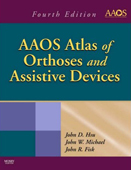Here's all the guidance you need to overcome the most difficult musculoskeletal problems using
orthoses and assistive devices! With new coverage of postpolio syndrome, cranial orthoses, and now
incorporating the perspectives of renowned physiatrists, this is a one-stop rehabilitation
resource. Tips and Pearls in every chapter and a new 2-color format make accessing information a
snap.
--------------------------------------------------------------------------------
목차
차 례
SECTION ONE: BASICS (Section Editor: John W. Michael)
Introduction
Chapter 1: International Organziation for Standization (ISO) Terminology
Chapter 2: The Orthotic Prescription
Chapter 3: Materials Science
Chapter 4: Principles of Fabrication
Chapter 5: Normal and Pathological Gait
SECTION TWO: SPINAL ORTHOSES (Section Editor: John R. Fisk)
Introduction
Chapter 6: Biomechanics of the Spine
Chapter 7: Principles and Components of Spinal Orthoses
Chapter 8: Orthoses for Spinal Pain
Chapter 9: Orthoses for Spinal Deformities
Chapter 10: Orthoses for Spinal Trauma and Postoperative Care
Chapter 11: Orthoses for Osteoporosis
SECTION 3: UPPER LIMB ORTHOSES (Section Editor: Mary Ann Keenan)
Introduction
Chapter 12: Biomechanics of the Upper Limb
Chapter 13: Principles and Components of Upper Limb Orthoses
Chapter 14: Upper Limb Orthoses for the Stroke and Brain-Injured Patient
Chapter 15: Upper Limb Orthoses for the Person with Spinal Cord Injury
Chapter 16: Orthoses for the Burned Hand
Chapter 17: Orthoses for the Arthritic Hand and Wrist
Chapter 18: Orthoses for Brachial Plexus Injuries
Chapter 19: Functional Bracing of Selected Upper Limb Fractures
Chapter 20: Protective Equipment to the Upper Limb in Sport
Chapter 21: Orthoses for Overuse Disorders of the Upper Limb
SECTION 4: LOWER LIMB ORTHOSES (Section Editor: Alberto Esquenazi)
Introduction
Chapter 22: Biomechanics of the Hip, Knee, and Ankle
Chapter 23: Biomechanics of the Foot
Chapter 24: Shoes and Shoe Modifications
Chapter 25: Foot Orthoses
Chapter 26: Principles and Components of Lower Limb Orthoses
Chapter 27: Lower Limb Orthoses for Persons with Spinal Cord Injury
Chapter 28: Orthoses in Total Joint Replacement
Chapter 29: Knee Orthoses for Sports-Related Disorders
Chapter 30: Orthotic Management of the Neuropathic and/or Dysvascular Patient
Chapter 31: Orthoses for Persons with Postpolio Syndrome
Chapter 32: Orthoses for Persons with Postpolio Sequelae
Chapter 33: Lower Limb Orthoses for Persons Having Had a Stroke
Chapter 34: Assessment and Othotic Management of Gait Dysfunction for Individuals with Traumatic
Brain Injury
SECTION 5: PEDIATRIC ORTHOSES (Section Editor: John D. Hsu)
Introduction
Chapter 35: Congenital and Acquired Disorders
Chapter 36: Pediatric Hip Orthoses
Chapter 37: Orthoses for the Muscle Disease Patient
Chapter 38: Orthoses for Cerebral Palsy
Chapter 39: Orthoses for Myelomeningocele
Chapter 40: Cranial Orthoses
SECTION 6: ASSISTIVE DEVICES (Section Editors: Sue Mukherjee & Debbie Gaebler)
Introduction
Chapter 41: Appropriate Technologies for Assistive Devices in Low-Income Countries
Chapter 42: Canes, Crutches, and Walkers
Chapter 43: Wheeled Mobility for Disabled Children and Adults
Chapter 44: Seating and Positioning for Disabled Children and Adults
Chapter 45: Wheelchair Prescription in International
Chapter 46: Communication Devices and Electronic Aids to Activities of Daily Living
Chapter 47: Sports Adaptations for the Physically Challenged Athlete
Chapter 48: Driving and Related Asisitve Devices
Chapter 49: Robotics
Chapter 50: Research and Future Trends


